Welcome to the lush world of Greece’s cutting-edge greenhouse farming practices! In recent years, this Mediterranean nation has seen a remarkable surge in greenhouse farming, revolutionizing the agricultural landscape. These controlled environments allow farmers to cultivate crops precisely, reducing dependency on unpredictable weather patterns and optimizing resource usage. Adopting advanced technologies, such as hydroponics and vertical farming, has significantly boosted crop yields while conserving water and land.
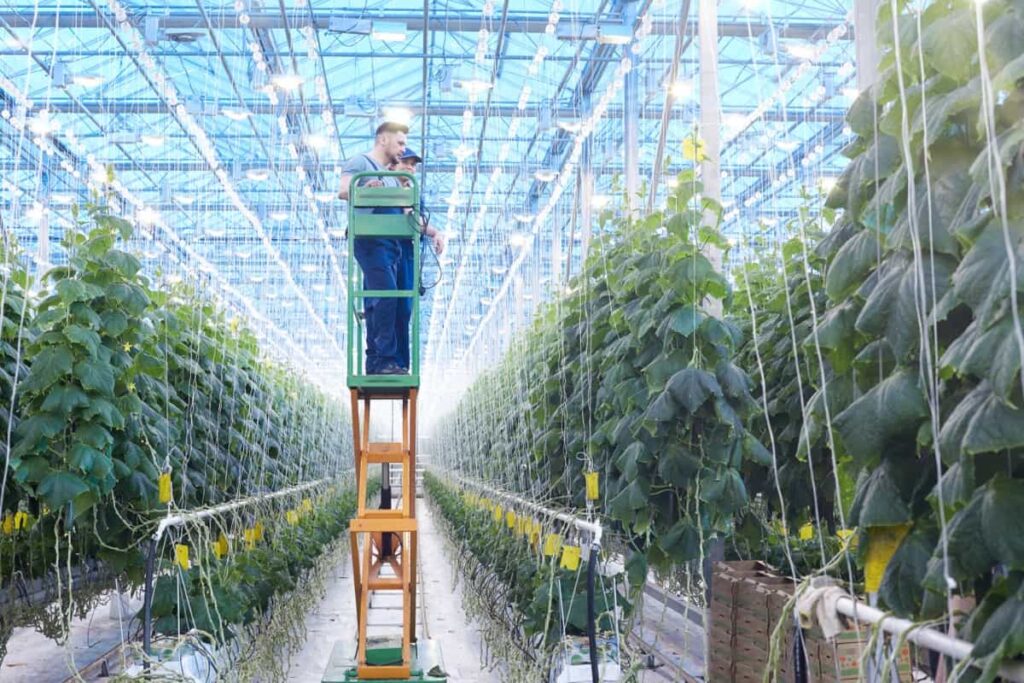
What is Greece Greenhouse Farming?
Greece’s greenhouse farming refers to cultivating crops within enclosed structures, allowing for controlled and optimized growth conditions. This agricultural method is gaining immense popularity due to its numerous benefits. One vital aspect is its ability to shield crops from harsh weather conditions, ensuring stable production year-round.
With unpredictable weather patterns affecting traditional farming, greenhouses offer a reliable solution to secure food supply. The country’s unique climatic conditions contribute to greenhouse farming success. Greece enjoys a Mediterranean climate characterized by hot, dry summers and mild winters. These conditions provide an ideal environment for growing different crops, from tomatoes and cucumbers to flowers and herbs.
Greenhouse farming in Greece is also highly resource-efficient. By employing water-saving irrigation systems like drip irrigation and adopting energy-saving technologies, farmers can significantly reduce water usage and carbon emissions. Additionally, the controlled environment helps minimize the need for chemical pesticides, promoting eco-friendly practices.
Basics of Agriculture in Greece
Agriculture in Greece revolves around small, family-owned farms scattered across the country. Arable land occupies 47.9%, while tree plantations make up 27.4%, vines 2.1%, and other cultivations, mainly used as pasture land, constitute 22.4%. Employing 615,000 farmers, agriculture accounts for 12.4% of the total labor force and contributes over 4.2% to the national GDP.
Covering a vast area of 2,824,449 hectares, it is the primary livelihood for rural communities. Greek agriculture is diverse, encompassing various crops and livestock products, with fisheries also playing a significant role. The sector benefits from subsidies under the Common Agricultural Policy (CAP), although some reductions are anticipated in the coming decade.
Modern Greek agriculture has advanced considerably from its basic 19th-century state. The major products are wheat, olive, maize, peach, and grape. Over the years, research and improved farming techniques have substantially boosted grain production. The number of farms has decreased, but organic farming has shown promising growth, covering 156,058 hectares in 2020. Greek agriculture’s evolution reflects progress and adaptability in meeting contemporary demands.
In case you missed it: Boosting Crop Yields and Income: A Guide to Greenhouse Farming in Tanzania
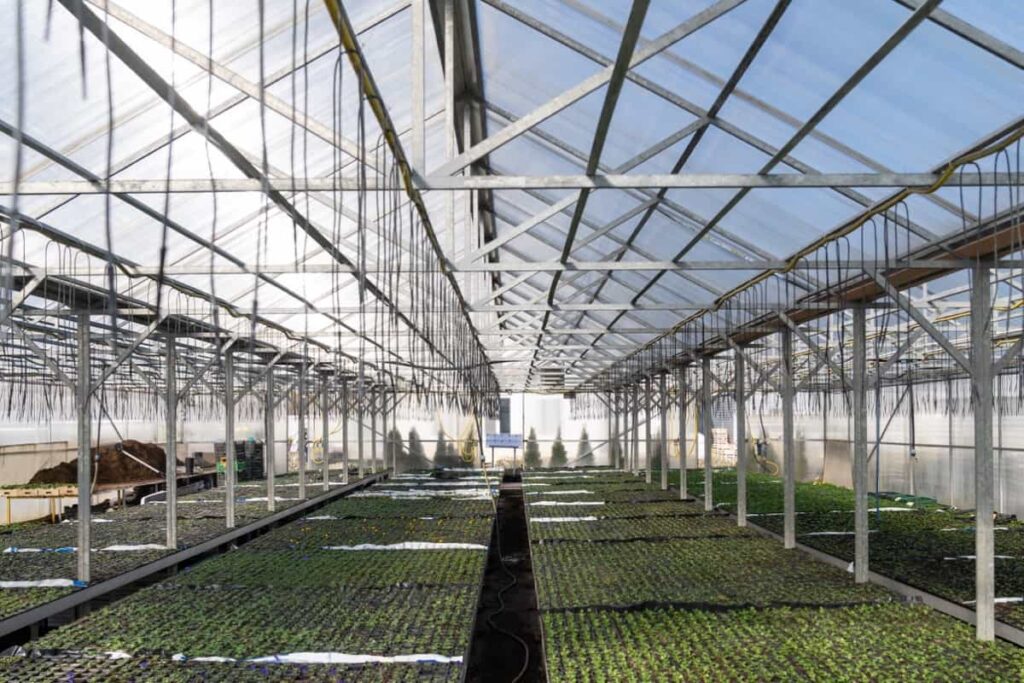
Types of Greenhouses in Greece
Plastic-Covered Greenhouses dominate the landscape, constituting around 93% of the total greenhouse area. Their lightweight construction and cost-effectiveness make them popular among vegetable growers. Plastic-covered greenhouses offer excellent insulation, protecting crops from adverse weather conditions and creating a controlled environment for optimal growth.
Glasshouses: Mainly used for floriculture, glasshouses provide better light transmission and durability. They offer more extended service life than plastic-covered greenhouses and are suitable for ornamental crops and specific vegetable varieties.
High Tunnels: Occupying a significant portion of the greenhouse area, high tunnels are versatile structures used for various vegetable crops. They provide protection from weather extremes, enhance crop yield, and allow for extended growing seasons.
Low Tunnels: Widely used for early melon, watermelon, and strawberry production, low tunnels are cost-effective and easy to manage. They offer localized protection to crops, promoting faster growth and early harvests.
Heated Greenhouses: Though a minor percentage (around 17%), some greenhouses are heated to maintain optimal temperatures during colder months. This heating is essential for achieving high yields and superior product quality.
Soilless Culture Greenhouses: These specialized greenhouses, covering approximately 180 ha, utilize soilless growing media like coco coir or hydroponics. Soilless culture ensures a precise nutrient supply, reduces soil-borne pathogens, and maximizes yields.
Greenhouse Farming Techniques in Greece
High Tunnels and Low Tunnels: High tunnels offer protective cover to crops, shielding them from adverse weather conditions and extending the growing season. Low tunnels, on the other hand, are cost-effective and commonly used for early crop production, such as melons, strawberries, and watermelons.
Plastic-Covered Greenhouses dominate the landscape, accounting for approximately 93% of the greenhouse area in Greece. The plastic cover provides an optimal environment for vegetable crops, ensuring temperature regulation, humidity control, and protection from pests.
Glasshouses for Floriculture: Glasshouses are applied primarily in floriculture, fostering the growth of flowers and ornamental plants. Their controlled environment enables year-round production.
Soilless Culture: Around 180 ha (approximately 3.3% of greenhouse area) in Greece is dedicated to soilless culture. This technique offers precise control over nutrient delivery, water usage, and disease prevention, promoting higher yields and resource efficiency.
Grafting and Soil Solarization: To combat soil-borne pathogens in intensively cultivated greenhouses, grafting and soil solarization are combined with soilless culture. This approach ensures safer and more effective practices, safeguarding crops and boosting productivity.
Computer-Controlled Automation: While automation is still limited in Greek greenhouse farming, computer-controlled systems are making their mark. These advanced technologies optimize resource usage, reduce labor requirements, and enhance crop management precision.
In case you missed it: Boosting Crop Yields and Income: A Guide to Greenhouse Farming in Tanzania
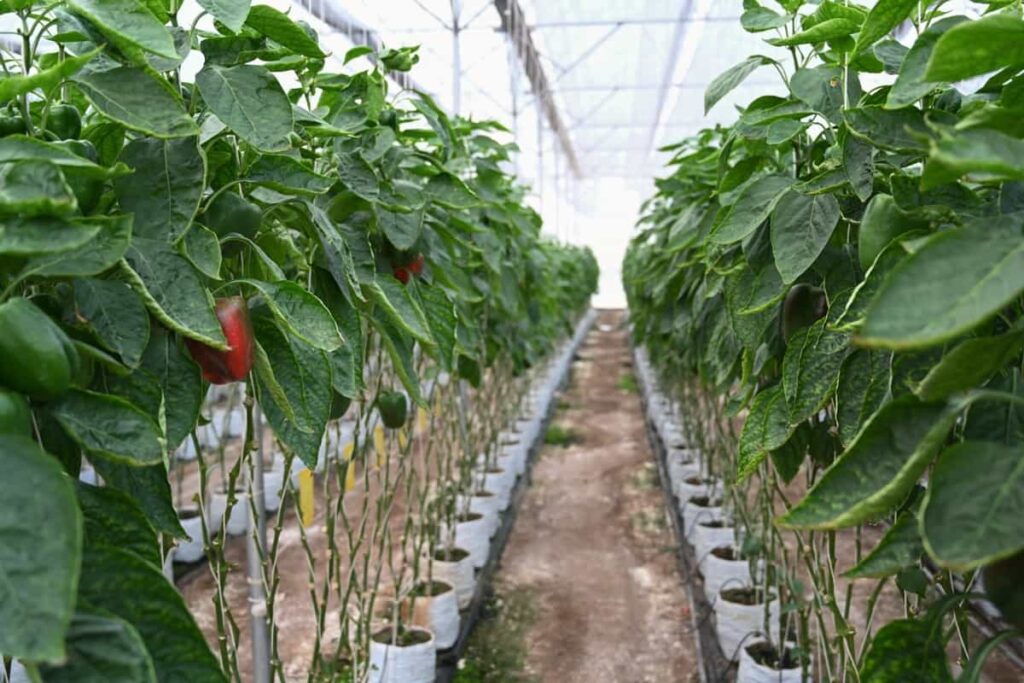
Benefits of Greenhouse Farming Techniques
- Year-Round Production: With controlled environments, greenhouse farming enables year-round cultivation, reducing reliance on seasonal weather conditions and ensuring consistent crop supply.
- Enhanced Crop Quality: Controlled conditions facilitate better growth, producing higher-quality, uniform produce that meets market demands.
- Resource Efficiency: Techniques like soilless culture and precise irrigation minimize water usage and nutrient wastage, promoting sustainable practices.
- Protection from External Threats: Greenhouses shield crops from pests, diseases, and extreme weather events, mitigating risks and potential losses.
- Higher Yields: With optimized growing conditions and resource management, greenhouse farming often increases crop yields, improving farmer profitability.
- Reduced Environmental Impact: Sustainable techniques and technologies contribute to a reduced carbon footprint, aligning with eco-friendly practices.
Sustainable Practices in Greece: Greenhouse Farming
- Location Selection: Choose a suitable site with ample sunlight, proper drainage, and access to water and utilities. Coastal areas with a Mediterranean climate offer ideal conditions.
- Greenhouse Design: Opt for a greenhouse design that suits your crop requirements, budget, and climate. Consider options like hoop houses, high tunnels, or plastic-covered structures.
- Crop Selection: Identify crops that thrive in greenhouses and have market demand. Popular choices include tomatoes, cucumbers, peppers, and leafy greens.
- Sustainable Inputs: Adopt eco-friendly practices using organic or biodegradable inputs, such as compost, natural fertilizers, and biopesticides. Practice crop rotation to maintain soil health.
- Water Management: Implement efficient irrigation systems like drip irrigation to conserve water and reduce wastage.
- Energy Efficiency: Consider renewable energy sources like solar to power the greenhouse, reducing carbon footprint and operating costs.
- Integrated Pest Management (IPM): Embrace IPM strategies to control pests and diseases using biological controls and beneficial insects, minimizing reliance on chemical pesticides.
- Soilless Culture: Employ hydroponic or aquaponic systems to grow crops without soil, ensuring efficient water and nutrient usage.
- Crop Monitoring: Regularly monitor plant health, nutrient levels, and environmental conditions to make informed decisions and optimize crop growth.
- Sustainable Packaging: Use eco-friendly packaging materials to minimize waste and promote sustainability.
- Market Research: Conduct market research to know consumer preferences and ensure your greenhouse produces in-demand crops.
In case you missed it: Advancing Sustainable Agriculture through Germany Greenhouse Farming
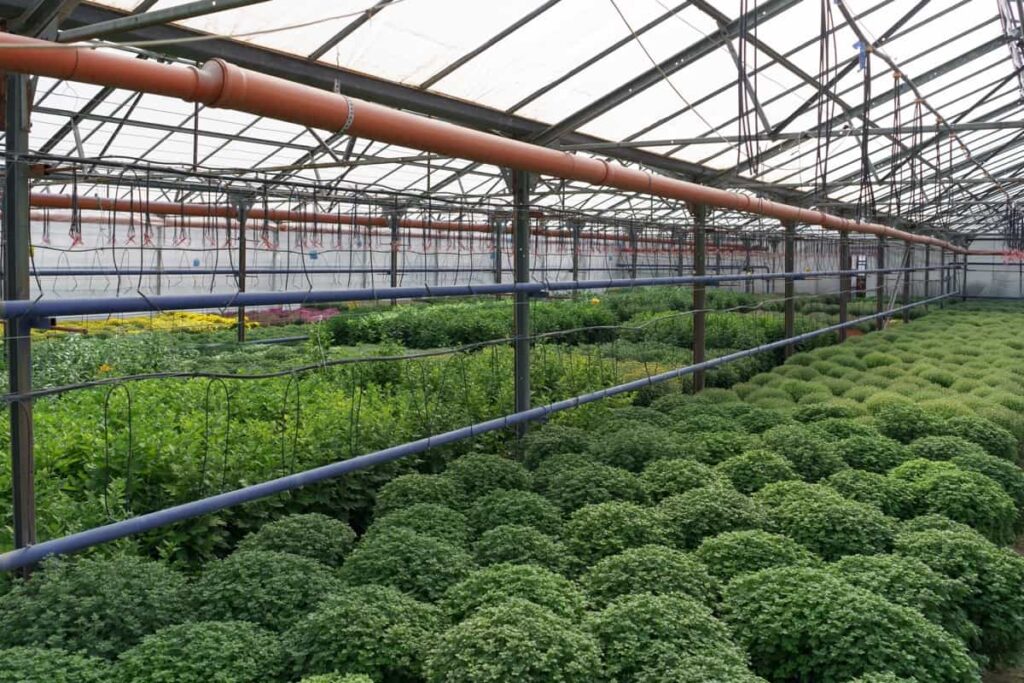
Greenhouse Vegetable Production in Greece
In Greece, greenhouse vegetable production plays a significant role in the agricultural landscape, covering around 0.12% of the total cultivated area. Out of the total greenhouse area, a substantial 92% (5,200 ha) is dedicated to vegetable production, while only 8% (400 ha) is allocated to ornamental crops. Plastic-covered greenhouses dominate, accounting for approximately 93% of the country’s total greenhouse area, with glasshouses mainly utilized for floriculture.
The primary vegetable crops in Greek greenhouses are tomatoes and cucumbers, followed by peppers. The leading region in greenhouse production is Crete, with Peloponnese, Macedonia, Thessaly, Central Greece, Epirus, and the Aegean Islands also contributing significantly. Greenhouses in Greece employ high and low tunnels, commonly used for early melon, watermelon, and strawberry production.
Surprisingly, only a minor portion, roughly 17%, of the greenhouse area used for vegetable production is heated, primarily due to the relatively high fuel costs. Nonetheless, winter heating is essential to maintain optimal temperatures for high yields and quality produce. Automation in Greek greenhouse vegetable production remains limited, with computer-controlled systems being the exception rather than the norm.
Despite this, the industry thrives with skilled growers employing soilless culture techniques on around 180 ha (approximately 3.3% of the total greenhouse area). Combining soil solarization and soilless culture with grafting effectively tackles soil-borne pathogens in intensively cultivated greenhouses.
Climate Control Systems for Greece’s Greenhouses
In Greece’s greenhouses, climate control systems are pivotal in creating optimal crop growth conditions. These systems manage temperature, humidity, and ventilation year-round to ensure healthy plant development. Advanced equipment maintains the desired temperature levels to combat the country’s Mediterranean climate with hot summers and mild winters.
Heating systems are often necessary during the colder months to safeguard crops and ensure consistent yields. Additionally, cooling systems are employed to counteract the scorching summer heat. Humidity control prevents disease outbreaks and maintains an ideal growth environment. Automated climate control solutions are gaining popularity, allowing precise adjustments based on real-time data. These advanced systems enhance energy efficiency and reduce human intervention, yielding cost savings and improved crop performance.
Crop Selection for Greece’s Greenhouse Farming
In Greece’s greenhouse farming, plastic-covered greenhouses dominate, accounting for nearly 93% of the total greenhouse area. Specifically, nearly 96% of greenhouses used for vegetable cultivation are plastic-covered, while glasshouses are mainly utilized for floriculture. The top vegetable crops cultivated in Greek greenhouses are tomatoes and cucumbers, closely followed by peppers. Crete is the leading region in greenhouse production, followed by Peloponnese, Macedonia, Thessaly, Central Greece, Epirus, and the Aegean Islands.
In case you missed it: Exploring the Innovative Techniques of Australian Greenhouse Farming
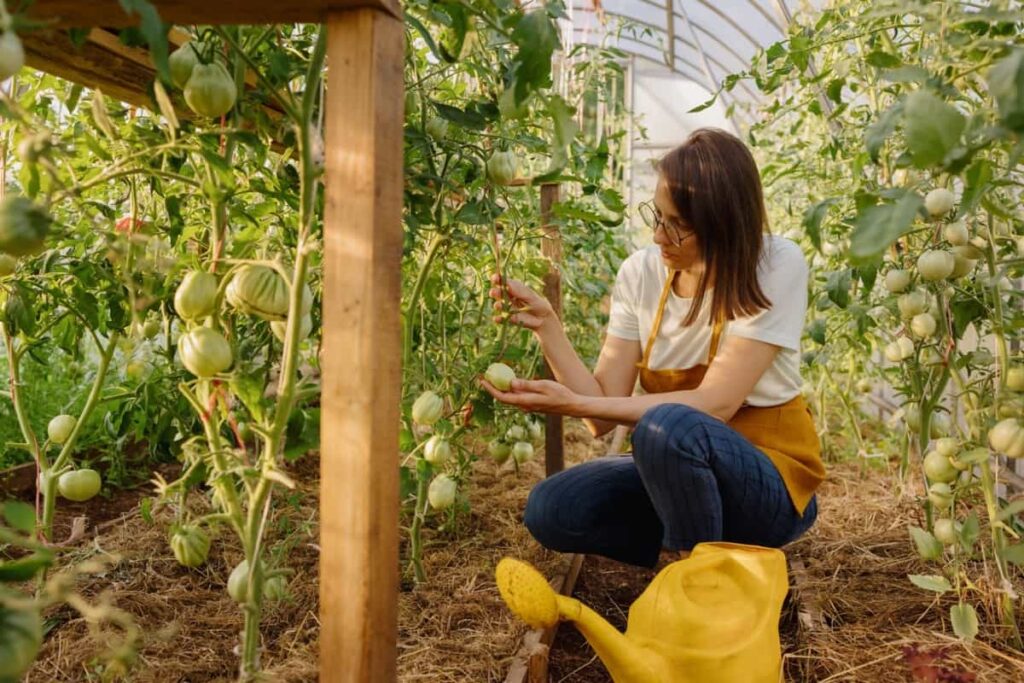
High tunnels occupy a significant portion of the greenhouse area used for vegetable production, providing controlled environments that optimize crop growth. Low tunnels are also commonly used, especially for early melon, watermelon, and strawberry production. Heating is relatively uncommon in Greek vegetable greenhouses, with only about 17% of the greenhouse area used for vegetable production employing heating systems.
The level of automation in greenhouse vegetable production still needs improvement, with computer-controlled systems being the exception rather than the norm. Despite challenges such as fuel costs for heating, Greek greenhouse farmers recognize the importance of maintaining proper temperature levels during winter to achieve high yields and superior product quality. Strategic crop selection and utilization of appropriate greenhouse technologies are critical to achieving successful and sustainable greenhouse farming practices in Greece.
Pest and Disease Management in Greece Greenhouse Farms
Integrated Pest Management (IPM) practices are widely adopted, emphasizing preventive measures and biological controls to minimize chemical pesticide usage. Beneficial insects and natural predators combat pests, maintaining a balanced ecosystem within the greenhouses. Regular monitoring and early detection help swiftly address potential pest or disease outbreaks. Growers prioritize crop rotation, sanitization, and quarantine protocols to prevent the spread of diseases. By employing sustainable and environmentally friendly approaches, Greek greenhouse farmers ensure the production of safe and high-quality vegetables and ornamental crops.
Greenhouse Automation Technologies in Greece
These advanced systems help monitor and regulate crucial parameters like temperature, humidity, irrigation, and ventilation. Though currently, not widespread, computer-controlled automation systems are increasingly making an impact on greenhouse vegetable production. Automation enhances energy efficiency and resource management by reducing manual intervention and ensuring real-time adjustments. Adopting these technologies empowers Greek farmers to achieve better yields, increase production efficiency, and contribute to sustainable agriculture.
Government Regulations for Greenhouse Farming in Greece
In Greece, government regulations related to greenhouse farming fall under the jurisdiction of the Ministry of Agriculture and Food. The ministry oversees and grants permissions for greenhouse construction and operation. Greenhouse farmers must adhere to the government’s specific guidelines and environmental standards to ensure sustainable and responsible agricultural practices.
Compliance with these regulations is essential to obtain the necessary permits for greenhouse establishment and to continue farming operations legally. The Ministry of Agriculture plays a vital role in maintaining the balance between agricultural development and environmental preservation in the greenhouse farming sector.
Market Trends and Opportunities in Greece: Greenhouse Farming
Greenhouse farming in Greece is witnessing positive market trends, with a significant 93% of the greenhouse area covered with plastic, mainly dedicated to vegetable production like tomatoes, cucumbers, and peppers. Crete leads greenhouse production, followed by other regions like Peloponnese and Thessaly.
Opportunities lie in leveraging advanced technologies to boost automation and energy efficiency, reducing heating costs in winter. The market demands high-quality, locally grown produce, presenting prospects for Greek greenhouse farmers to meet consumer preferences and capitalize on sustainable agriculture practices.
Success Story: Greenhouse Production in Greece
Haifa Group’s CEOs, Motti Levin, and Thanasis Rosoglou, explored the vibrant greenhouse vegetable production hub in Crete and Ierapetra, Greece. They engaged with influential figures like Mr. George Hatzakis of GEOMARKET, witnessing his impressive hydroponic greenhouses covering 6 hectares. Understanding the challenges of out-of-season tomato production became a priority.
In case you missed it: Eggplant Companion Plants: Benefits and High Yields
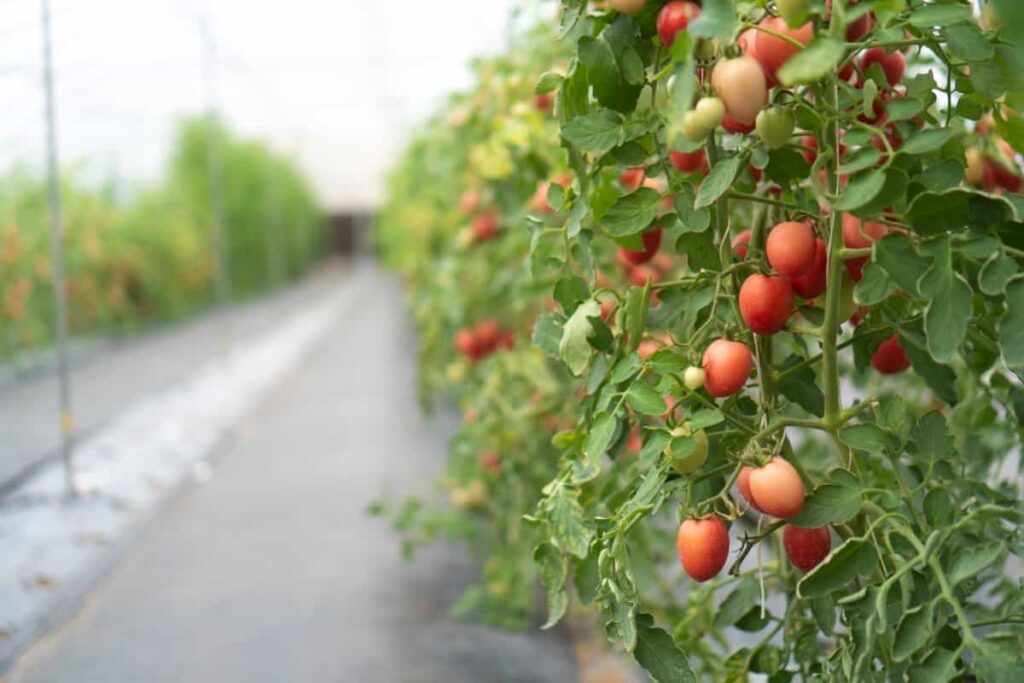
Next, they visited Agroshop SYNTAGI, owned by the innovative Antonakis brothers, with their high-tech hydroponic greenhouses spanning 8 hectares, managed remotely. Haifa’s cutting-edge nutritional solutions for soilless crops proved vital, including Multi-K™ Reci with low sodium, Haifa VitaPhos-K™ for superior phosphorus supply, and Haifa GrowClean™ for clean irrigation without added acid. Haifa Cal™ Prime emerged as an ideal calcium fertilizer.
Conclusion
Greece’s greenhouse farming demonstrates promising growth potential, focusing on vegetable production. Embracing technology and sustainable practices will enable farmers to meet market demands, boost efficiency, and ensure a fruitful and eco-friendly future.
- Management Pests and Diseases in Your Cotton Field
- Sheep Farming Business Plan for Beginners
- Aquaponic Farming at Home: A Step-By-Step Guide
- Profitable Village Farming Business Ideas in 2024
- High-Yield Aquaculture: Fast-Growing Fish for Farming
- Effective Fish Pond Construction Techniques for Beginners
- Irrigation and Water Management in Pineapple Farming
- Blossom to Harvest: Mastering Flowering and Pollination in Papaya Farming
- Pig Fattening Essentials: From Selection to Sale for Beginners
- Raising Wagyu Cattle: A Complete Guide for Premium Beef Production
- Soil Types and Their Water Holding Capacity
- Optimizing Irrigation Schedules for Coconut Groves for Enhanced Yield
- Espresso Your Garden: Coffee Grounds for Healthier Acid-Loving Plants
- The Best Soil Mix for Snake Plants: How to Mix Your Own Snake Plant Soil
- Green Thumb Success: Expert Tips for Cultivating Greenhouse Beans All Year Round
- Bloom All Year Round: The Ultimate Guide to Indoor Hyacinth Care
- Eco-Friendly Gardening: How to Make Liquid Fertilizer from Kitchen Waste
- Ultimate Guide to Grow Anise in Pots: Explore Seed Propagation to Harvesting
- Guide to Raising Chester White Pigs: Discover Breed Facts to Growth Management
- Mastering the Elegance: The Ultimate Guide to Weeping Cherry Tree Care, Planting, and Maintenance
- Ultimate Guide to Planting Garlic in Grow Bags: Growing Strategies for Beginners
- How to Fix Spider Plant Leaf-Related Problems: Natural and Organic Remedies
- 10 Reasons Why Your Tulsi Plant is Shedding Leaves: Home Remedies and Solutions
- Optimizing Growth and Yield: The Advantages of Palm Bunch Ash Fertilizer
- Utilizing Neem Oil Extract as a Natural Pesticide for Hydrangea
- From Soil to Harvest: Various Ways in Which Farmers Can Use AI Tools
- Steps to Encourage and Induce Citrus Flowers: A Comprehensive Guide
- How to Fix Snake Plant Leaf-Related Issues: Natural and Organic Remedies
- Transform Your Garden into a Fragrant Oasis with Raat Ki Rani (Night Blooming Jasmine)
- Discover the Ideal Chicken Breeds for Philippine Farms
- How to Create a Poultry Egg Farm Business Plan for Profits
- Grow Lemon Cucumbers Like a Pro: Insider Techniques for Bountiful Yields
- Ultimate Guide to Caring for Your Pink Princess Philodendron: Tips for Thriving Variegation
- Areca Nut Profit Per Acre: Calculating Yield and Cost of Cultivation
- How Kaveri Chicken is Becoming a More Profitable Breed in Indian Backyards
- Transform Your Barn: 9 Steps to Convert a Horse Stall into a Chicken Coop

How can I make success full organic farming with advanced technology.